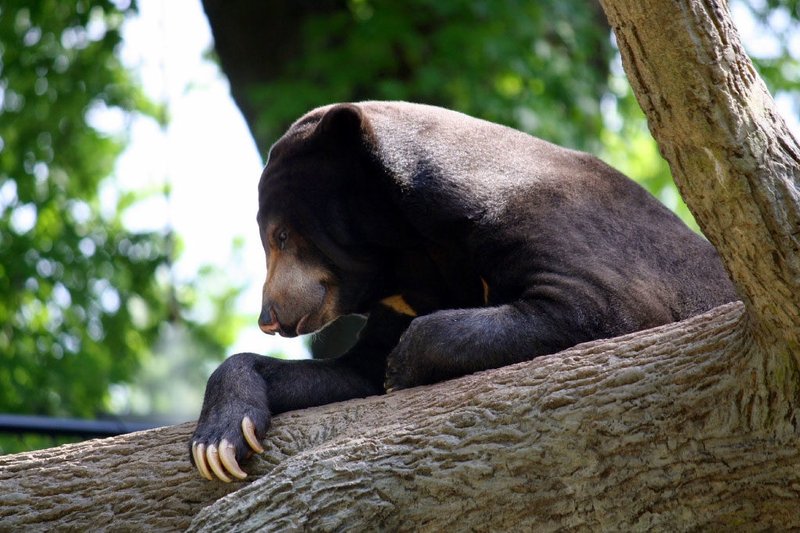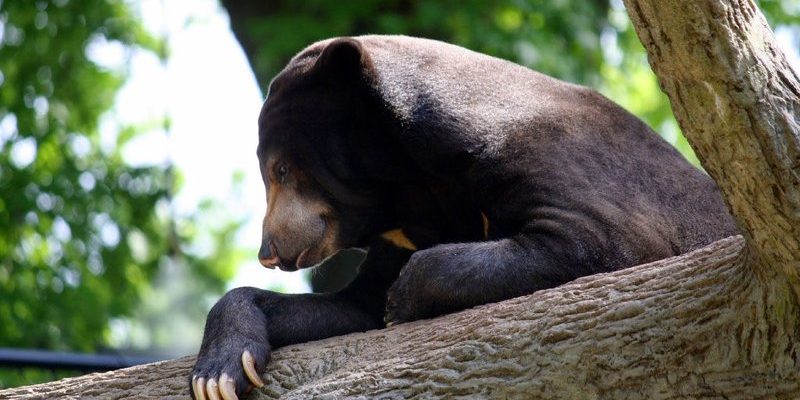
Let’s dive into how the sun bear’s unique lifestyle and habits support their environment, ensuring everything runs smoothly—like a well-oiled machine. From their diet to their behavior, each aspect of the sun bear’s life contributes significantly to the ecosystem they inhabit. So, grab your coffee, and let’s unpack the fascinating world of the sun bear!
Who Are Sun Bears?
Sun bears (Ursus malayanus) hold the title of the smallest bear species in the world, with adults typically weighing between 60 to 150 pounds. They have a distinctive, short coat, often dark brown or black, with a unique yellow or white crescent-shaped marking on their chest. Picture a teddy bear but more agile and mysterious. Their size might make them seem less intimidating than, say, a grizzly, but don’t let that fool you! These bears are well-adapted to their tropical forest homes with strong claws and long tongues perfect for reaching honey and insects.
Now, you might be wondering why they’re so important in their ecosystem. Their role goes beyond being just cute faces. Sun bears are often referred to as “honey bears” because of their love for honey. But what’s more interesting is how their foraging habits impact their environment.
Foragers and Seed Dispersers
Sun bears are omnivores, which means they eat both plants and animals. Their diet mainly consists of fruits, insects, and honey. By munching on fruits like figs and durians, they play a vital role in seed dispersal. When they eat these fruits, they consume seeds that eventually pass through their digestive systems. This not only helps in the germination of new plants but also aids in maintaining forest diversity.
Imagine a sun bear munching on a juicy fruit, wandering through the forest, and leaving behind seeds that sprout into trees. This natural process not only promotes plant growth but also provides food for other animals. With a rich and diverse plant life, the area can support various animal species, thus creating a balanced ecosystem.
Climate Regulators
Let’s take a moment to consider the broader impact of sun bears on their environment. By facilitating plant growth, they contribute significantly to carbon sequestration. Healthy forests act as carbon sinks, meaning they absorb carbon dioxide from the atmosphere and help combat climate change. As sun bears roam and forage, they’re indirectly helping to regulate the climate in their habitats.
If you think about it, the activities of these little bears can create a ripple effect that extends far beyond their immediate surroundings. When forests thrive, they provide habitats for countless other species, contributing to overall biodiversity. So, each time a sun bear forages, it’s like they’re throwing a “party” for the entire ecosystem to benefit from.
Helping Control Insect Populations
You might be surprised to find out that sun bears are also natural pest controllers. With their long tongues, they expertly extract insects and larvae from trees and soil. Think of them as nature’s little exterminators! By keeping insect populations in check, they prevent potential outbreaks that could harm nearby plants and other animals.
Imagine a sun bear digging into a rotting log to find a tasty treat. While doing this, they also help aerate the soil and enhance nutrient cycling. This is crucial for plant growth, as it encourages healthier ecosystems and stronger vegetation. Without these bears, insect populations could rise unchecked, leading to imbalances that affect the entire ecosystem.
The Interconnected Web of Life
In the grand tapestry of nature, every species has its role, including the sun bear. They’re not just solitary foragers but part of a complex web of life. By interacting with their surroundings, they help maintain the balance of various ecosystems. For instance, their presence can influence other wildlife behaviors and population dynamics.
Sun bears often share their habitats with other animals, such as monkeys and birds, which depend on the same food sources. Their foraging patterns might change the availability of resources for these species, creating a dynamic environment. When one species thrives, it can positively affect the overall health of the ecosystem.
Threats to Sun Bears and Their Ecosystem
Unfortunately, sun bears face numerous threats that jeopardize their existence and the delicate balance of their ecosystems. Habitat loss due to deforestation for agriculture, logging, and urban development is a significant challenge. As their homes disappear, sun bears are forced into smaller areas, making it harder for them to find food and mate.
Additionally, they are often hunted for their body parts, which are used in traditional medicine. This not only reduces their population but also disrupts the natural dynamics of the forest. If sun bears continue to decline, the entire ecosystem could be affected. We could see more pests, fewer plants, and an overall less diverse environment.
Conservation Efforts and What You Can Do
So, what can be done to protect these incredible creatures and their ecosystems? Conservation organizations are working tirelessly to raise awareness about the plight of sun bears. They focus on habitat preservation, anti-poaching efforts, and community education. Supporting these initiatives can help ensure a brighter future for sun bears and the ecosystems they enrich.
Here’s the thing: every little action counts. You can contribute by spreading awareness, supporting conservation efforts, or even adopting a bear through various wildlife charities. When we all pitch in, we can help protect not just the sun bears but the vibrant ecosystems they support.
Final Thoughts
In summary, sun bears might be small, but their role in the ecosystem is anything but insignificant. From seed dispersers to climate regulators, these remarkable animals contribute to the health and balance of their habitats. By understanding their importance, we can appreciate the delicate threads that connect all living beings in our world.
Next time you think about bears, remember the quiet heroics of the sun bear, working hard behind the scenes to keep nature’s wheels turning. Let’s do our part to protect them so they can continue their invaluable work in the wild. Together, we can ensure that these fascinating creatures and their ecosystems thrive for generations to come.

